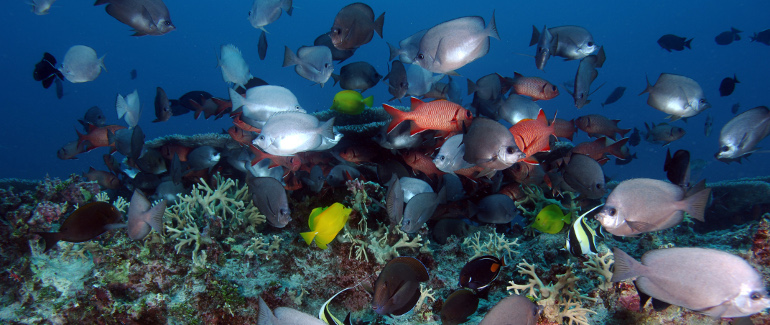| HOME | BLOG | CONNECT | SITE MAP | CONTACT |


|
|
A wide variety of fish at Pearl and Hermes Atolls in Papahanaumokuakea Marine National Monument, also a UNESCO World Heritage site.
Public Domain Photo |
|
Hawaii - Other Types of Sites Much like with the U.S. Forest Service and the Bureau of Land Management, there are other sites to mention that have little to no footprint in Hawaii. This is not an exhaustive list but it will give you an idea of other opportunities for experiencing life throughout the country. One type of location that can be found on the mainland, primarily in the southwest, is a tribal park. This is another type of government-administered park surrounded by the United States but technically not part of it. The various reservations for Native Americans are sovereign nations and so have their own governments. The nice thing is that you do not need a passport to enter these nations. Some examples of tribal parks include the famous Monument Valley park, in the Navajo Nation, and the Ute Mountain Tribal Park in the Ute Mountain reservation. These are gorgeous areas for experiencing life. Another type of location, with which we are familiar from many of the Experiencing Life trips, is a museum. Our focus, of course, has been on natural history and science museums. Hawaii does not have a typical museum that focuses on science or natural history in a traditional way, but there are a couple non-traditional options. The Hawaii Nature Center is sometimes listed as a museum but it's outdoors and by appointment, so it's not a typical museum. The Hawaii Science & Technology Museum is also listed as a museum usually, but it's mobile so it's not a typical museum either. It is also geared towards kids. The Bishop Museum is described as a natural history museum, and it is. The focus there though is more on the cultural history of Hawaii than on the biological or scientific history. In our series of trips, some notable museums have been the Denver Museum of Nature and Science, the Field Museum, the American Museum of Natural History and the Smithsonian National Museum of Natural History. There are many more throughout the country that are high-quality and worth a visit. There are some parts of the world that are public but are not governed by anyone, except general national or international law. About the only places that fit into this category would be oceans and Antarctica. These could be potential places for experiencing life. Within the U.S., the oceans bordering the country, that are not within a marine sanctuary, are also public and waiting to be experienced. There would not be any physical visitor center for orientation so it's up to you to get out in it. You could do this on your own or with a commercial outfitter as a guide. In fact, commercial operators can be an option for experiencing life within all the types of locations. The examples would be too numerous to list but some examples in Hawaii would be a boating company who could take you whale watching (within a marine sanctuary or not), a different boating company that could take you scuba diving or snorkling, a plane company who could take you flying over Hawaii's volcanoes, or a bus company that could take you through some of Hawaii's rainforests. It is also possible for private individuals to own land that they allow to be accessed by the public. Private individuals can make up their own rules for how their land can be used by the public so make sure you know what the rules are before you access private property. Sites designated as Long Term Ecological Research (LTER) sites are not administered by any one entity. The organization that names sites as LTER sites is the National Science Foundation, so they play a role in each site, but they do not own the property of the sites. The thing that connects all LTER sites is their role in the scientific study of ecology over long time periods and sometimes distances. LTER sites from the Experiencing Life series include the following:
Another designation an area can have is that of a UNESCO World Heritage site. In Hawaii, the two UNESCO sites are Hawaii Volcanoes National Park and the Papahanaumokuakea National Marine Sanctuary. Like the LTER sites, UNESCO World Heritage sites are not governed by any one administrative body. UNESCO stands for United Nations Educational, Scientific and Cultural Organization, which is the group that designates which sites are world heritage sites. As the name implies, UNESCO has a worldwide scope. Within the Experiencing Life series of trips, the following are UNESCO World Heritage site:
|
|
Trip Menu
|
|
Other Sites in Hawaii Map Sources:
experiencinglifetrips@gmail.com |
